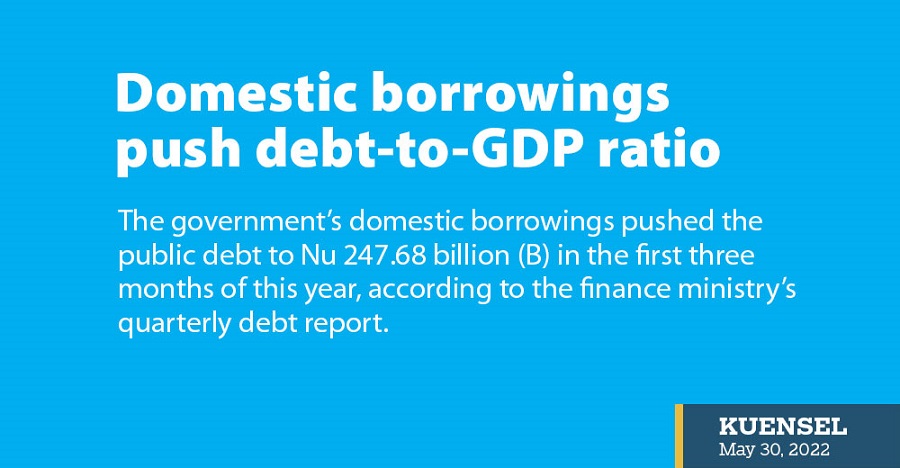
The government’s domestic borrowings pushed the public debt to Nu 247.68 billion (B) in the first three months of this year, according to the finance ministry’s quarterly debt report.
This is an increase of 3.3 percent or Nu 7.889B from December last year. Public debt accounted for 130.9 percent of the gross domestic product (GDP) estimates for the fiscal year 2021-22.
The increase was attributed to governments borrowing Nu 8.5B from the issuance of a new treasury bill (T-bill) during the first quarter which increased the domestic debt by 49.8 percent. Domestic debt accounted for 10.3 percent of total public debt reported at Nu 25.57B.
T-bill is short-term debt obligations backed by the government with a maturity of less than one year. It is issued when the government needs money for a short period.
With expected shortfalls in domestic revenue, the finance ministry expects the government to be short of Nu 17.15B to spend in this fiscal year 2021-22.
The report stated that domestic debt comprised of Nu 18.5B T-bill, Nu 6.7B government bond, and remaining loan outstanding to the National Pension and Provident Fund borrowed to construct staff quarters for Phuntsholing Hospital and the liquidation of Bhutan Hydropower Services loan to the Deutsche Investitions, Germany.
Meanwhile, external debt decreased slightly because of Mangdechhu hydro project Authority’s (MHPA) loan repayment of Nu 610.53 million (0.3 percent) in January this year to Nu 222.72B.
Major share of the country’s debt was from the six hydropower projects in the country. At Nu 162.197B, hydro-debt contributed to 73 percent of the total external debt.
Non-hydro debt stood at Nu. 59.91B, constituting 27 percent of total external debt.
“The non-hydro debt to GDP of 31.7 percent is within the 35 percent threshold prescribed by the
Public Debt Policy 2016,’ the report stated.
The report also stated that the external debt servicing in the fiscal year 2021-22 is expected to increase by more than 100 percent compared with the prior year’s external debt servicing because of full annual debt servicing for MHPA and liquidation of Standby Credit Facility of INR 4B.
From the fiscal year 2026-27 until 2036-37, external debt servicing is expected to increase significantly because of the start of loan repayment for all mega hydropower projects.
However, repayment is projected to drop after the liquidation of loan for MHPA by fiscal year 2037-38 and Puna-II by fiscal year 2038-39.
Finance ministry stated that the overall debt risk is manageable because the major portion of external debt is on account of hydropower projects which are deemed commercially viable, with a ready export market in India.
Additionally, the report stated that 91.2 percent of the hydro-debt denominated in Indian rupee (INR) does not pose any exchange rate risks with Ngultrum pegged at par with INR. It added that with the long average time to re-fixing the debt estimated at 9.2 years and low portion of the variable-interest-rate debt, the interest rate risk is deemed low. The fixed interest rate debt constituted 95.6 percent of the total public debt.
INR denominated debt accounted for 69.7 percent of total external debt at Nu 154.9B and the convertible currency debt was USD 884.191M which is equivalent to Nu 67.20B as of March this year.



